Located on the west coast of Canada in the British Columbia province, Vancouver is a bustling metropolis that also boasts stunning natural beauty and a diverse culture. Spending 2 days in Vancouver will give you a taste of all that the city has to offer.
I have been to Vancouver twice now and I’ve fallen more and more in love each time – and am always itching to come back for more!
Canada is home to some amazing travel destinations (like Montreal, Quebec City, and Banff), but Vancouver is one of my all-time favorite cities. I’ve always loved the urban city vibes combined with nature, along with the diversity and amazing food. It’s truly one of the best cities in the Pacific Northwest, and reminds me a lot of Seattle, another one of my all-time favorite cities.
Sure, it does rain quite a bit here (Vancouver is often nicknamed “Raincouver”), but the city has so much to offer that more than makes up for it – and there’s plenty to do and see despite the rain!
Keep on reading to find out everything you need to do, see, and eat in the perfect Vancouver 2 days!
Disclosure: This post contains affiliate links. This means that if you make a purchase or booking, I may receive a small commission at no additional cost to you. Pictures & Words is a participant in the Amazon Services LLC Associates Program, an affiliate advertising program designed to provide a means for us to earn fees by linking to amazon.com and affiliated sites at no cost to you.
Headed to Vancouver soon? If you’re going to Vancouver and short on time, here are some of my top picks to help you plan the perfect trip!
Top attractions in Vancouver:
Best tours in Vancouver:
- Granville Island Food Tour
- Gastown Walking Food Tour
- Lost Souls of Gastown Tour
- Classic Panorama Tour by Seaplane
Where to stay in Vancouver:
Car rentals: While you don’t need a car to explore the top attractions in Vancouver, you may want one if you’re planning to take day trips. For the best rates, I recommend booking on rentalcars.com, which allows you to compare prices from the top car rental companies and offers a price match guarantee.

Can you really see Vancouver in 2 days?
Short answer – YES!
While there is much more to do + see (and most importantly, EAT!) than can be done in a weekend, it is enough time to see the highlights and see what the city has to offer. You’ll get a little taste of everything in this Vancouver 2 day itinerary – urban city vibes, soak in some of its nature, experience some of its culture, and eat some of its best food.
If you have more time, you will be able to take some day trips and really take advantage of all the nature that surrounds the city. This is one thing I want to do in the future – go hiking in the mountains, and even ski in Whistler!
If you have less time, you can accomplish the majority of this 2 day Vancouver itinerary. However, you would have to skip the Capilano Suspension Bridge + spend far less time in Stanley Park to make it possible.

When to visit Vancouver
There really is no bad time to visit Vancouver, as temperatures stay relatively mild year-round compared to other parts of Canada. However, in typical PNW fashion, Vancouver can be a bit rainy depending on the time of year. I would say that the weather in Vancouver is very similar to that of Seattle.
Generally speaking, the summer months are considered to be the best times to visit, when temperatures are at their warmest (highs average 73°/23°). July and August are when the city get the least amount of precipitation (less than one inch on average), and is an ideal time to visit if you want to spend a lot of time outdoors and/or take advantage of nearby hiking opportunities
However, do note that since these are the most popular times to visit, flight and accommodation prices are at their highest, and hotels can go for well over $300 a night.
May-June, and September are also a great time to visit, as they are the next driest months (1-1.5 inches of precipitation on average). However, do note that the weather can still be unpredictable and you can still end up experiencing pouring rain at times!
The spring months (March/April) can also be a beautiful time, as the cherry blossoms bloom across the city. Similarly, autumn (October/November) is also stunning, as the foliage transforms into vibrant shades of red, orange, and yellow.
Vancouver in winter is relatively mild, especially compared to other parts of Canada (i.e. Quebec City and Montreal). Average winter highs are around 45°F/7°C, with lows around 35°F/2°C. These are the wettest months of the year, and there are around 5 inches of rainfall during the winter months. While the city only receives about 3 inches of snowfall, there are plenty of winter recreation activities in the surrounding mountain areas.

So…how much does it rain in Vancouver??
Since Vancouver often gets nicknamed “Raincouver,” you may wonder…”how much does it rain in Vancouver?”
The city does receive 92.6 inches of rain each year, so you could say that it does rain a bit (not quite as much as Ketchikan, Alaska though, which gets a whopping 141 inches…or even the Hoh Rainforest in Olympic National Park!).
The first time I visited Vancouver was in April, and I experienced a ton of rain (and got caught in a torrential downpour while biking in Stanley Park. But more on that later). The second time I visited was in June, and I thought it would be much drier – I was wrong though, because we got caught in some pouring rain then too (good thing I came better prepared this time).
So basically – bring a raincoat and/or umbrella! They don’t call it “Raincover” for nothing.
And rest assured that even if it *does* rain during your stay, don’t let it derail your Vancouver trip trip itinerary – there is still plenty to do in the city in the rain!
Rain forecasted during your trip? Not to worry – here’s my guide to 30 fun things to do in Vancouver when it rains!
How to get to Vancouver, Canada

By Air
Located 15 kilometers from the city, Vancouver International Airport (YVR) is the city’s air hub, and offers flights to many major destinations across Canada and internationally.
From here, you have several options for getting to the city center:
- Public transportation: Taking the Skytrain is an easy + affordable way to get into downtown Vancouver. Simply follow the signs in the terminal to the Skytrain station and hop on the Canada Line. The train runs from around 5am-1am every day, with frequency up to every 7 minutes during peak hours (and every 12-20 minutes during off-peak times). The trip takes roughly 25 minutes, and a one-way fare costs $8.10-$9.45 CAD depending on time of day. You can buy your ticket at the automated terminals at the station. More on schedules and fares here.
- Uber/Lyft: Rideshare services are available to/from YVR airport via Uber and Lyft. This costs $25-30, but can be more depending on demand/traffic.
- Taxi: There is a taxi stand located right outside the terminal. There are set fares depending on where you are headed in the city.
- Rental Car: While a car is not necessary in Vancouver, you may consider renting one if you are planning to complete day trips. YVR airport is served by most major car rental agencies. The car rental center is located on the ground floor of the parkade.
By Train
Another way to get to Vancouver is via train. The Amtrak Cascades Route provides rail service from Seattle, even going all the way to Eugene, OR (although only one daily train is operating at this time, with service ending in Seattle).
The trip takes roughly 4 ½ hours, and a one-way ticket costs $44. While it does take a little bit longer than driving, this is something I’ve always wanted to do – I’ve heard the mountain views are insane throughout, and it looks so relaxing!
Trains arrive at the Pacific Central Station, near the Science World museum. From here, you can easily connect to other destinations in downtown Vancouver via bus, light rail, or rideshare.
If you take the train, be sure to allow extra time before departure for customs inspection.
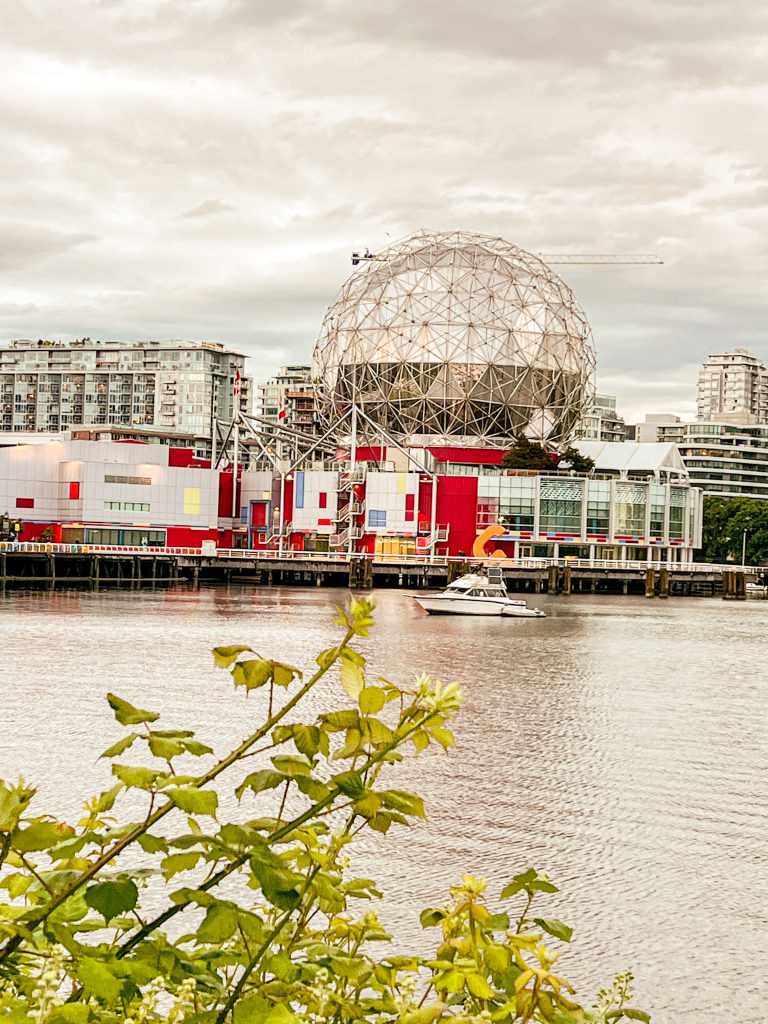
Driving
Vancouver is a common stop on a Pacific Northwest road trip, or on the way to/from other destinations in British Columbia and Alberta (i.e. Banff National Park).
Driving across the border from Seattle takes roughly 3 hours, however this can vary greatly depending on traffic on the I-5 and border wait times. Avoid popular travel times if possible, such as Friday evenings and holiday weekends.
As you approach Bellingham, you will start to see the expected wait times or you can check online here. The Peace Arch crossing is the most popular and straightforward, but do note that it may have longer wait times.
Cruise Ship
Vancouver is a common starting point and/or port stop for Alaska cruises. The cruise ship terminal is located at Canada Place in the heart of downtown Vancouver, making it super easy and convenient to get to all of the city’s top attractions. If you need to store your luggage, you can do so here.
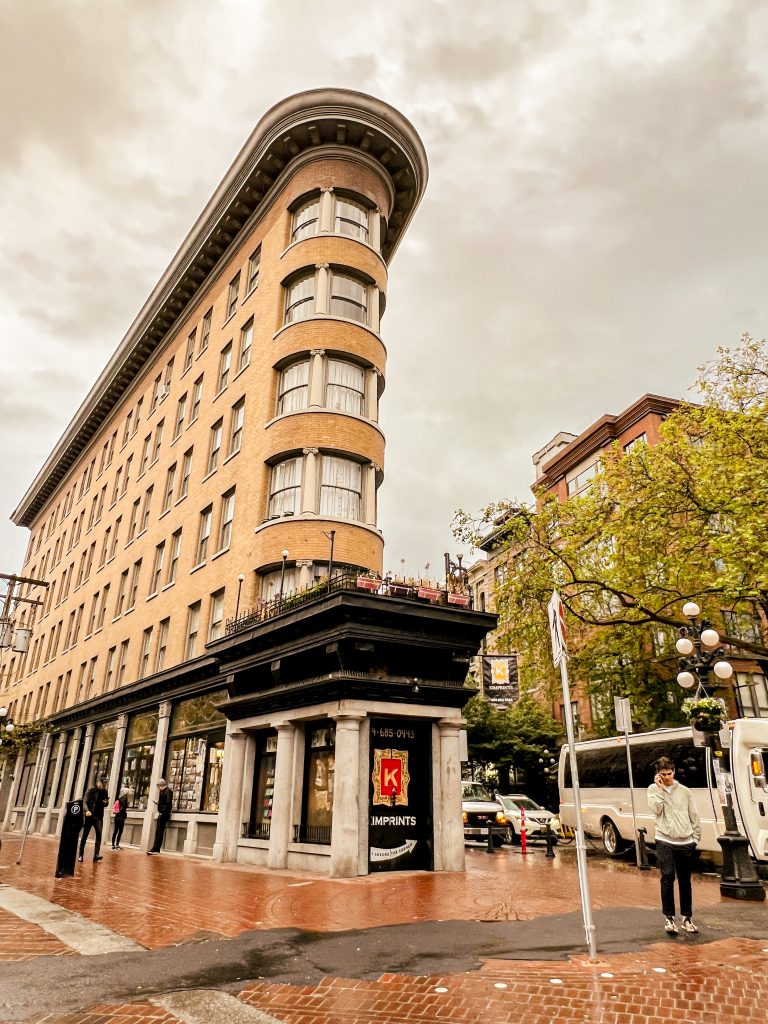
Getting around in Vancouver
It is a breeze to get around Vancouver! We mostly got around on foot and via Uber/Lyft during our 2 days in Vancouver, but here is an overview of the different ways you can get around the city:
On foot
Vancouver is a very walkable city, and exploring on foot really lets you see the beauty of the city. Downtown Vancouver is relatively compact, and you can get from one end to the other in less than 30 minutes, meaning that you can cover a lot of ground just by walking.
On bicycle
Vancouver is a very bike-friendly city, and hopping on a bike is another fantastic way to get around the city during your 2 days in Vancouver.
Mobi Bikes is the city’s bike sharing service, and you can find terminals all around town, where you can check out classic or electric bicycles. A 24 hour pass with unlimited 30 minute rentals costs $15 CAD, or you can pay based on time used. Download the app to unlock bikes and pay for your rental.
There are also plenty of bike rental shops around the city, especially around Stanley Park. They offer both hourly and all-day rentals.
Public transit
Vancouver has a relatively easy-to-use and well-connected public transportation system that will get you to anywhere you need to go. The city’s public transit is operated by Translink, and consists of the bus network, the SkyTrain light rail, and the SeaBus ferry, which run across the Burrard Inlet.
Fares are calculated by zones – most, if not all, of the places you will visit during your weekend in Vancouver should stay within one zone. Travel within one zone costs $3.10 CAD, and fares can be paid at a terminal in a SkyTrain Station, via contactless payment on your phone via Apple/Google/Samsung Pay, or by cash on buses.
You can also purchase a reloadable Compass Card for discounted fares. The card costs $6 (which is technically a deposit), but once you have it, it will automatically calculate the lowest fares for you.
If you plan to use public transportation often during your stay in Vancouver, consider purchasing a transit day pass for $11 CAD. If you plan to use transit more than three times a day, then this is worth it.

Rideshare
Both Uber and Lyft operate in Vancouver, and is an easy way to get around for those times you can’t or don’t want to walk. Cars were relatively easy to find whenever we needed one. Rides cost $10-15 CAD around central Vancouver.
AquaBus + False Creek Ferries
These privately run ferries run up and down False Creek, making stops at numerous docks along the way. It’s a fun way to get to and from some of the city’s points of interest, including Granville Island, Science World, Yaletown, the West End, and more.
Fares range based on zone (I’ve noticed that the False Creek Ferries are slightly cheaper than the AquaBus), or you can buy a day pass for unlimited rides. Fares can be paid on board with cash, credit, or debit cards.
Hop-On, Hop-Off Bus
A hop-on, hop-off bus tour is a fantastic way to get around and see the top sights without having to think about how to get around! I used to always dismiss these tours as super touristy and lame, but I’ve grown to really like them these days. It’s an awesome way to learn more about the city and the attractions you’re visiting – you’ll hear fascinating tales of the city’s history told by a Vancouver local.
Driving
It is not necessary to have a car for this Vancouver 2 day itinerary. All of the places I’ve included in this itinerary are easily accessible by the modes of transportation above.
Having a car makes sense if you are planning to visit more nature spots, or want to take day trips. However, if you are trying to see Vancouver in 2 days, you probably won’t have time for that.
If you do choose to drive, here is a guide to where to park in Vancouver. As parking may be difficult to find in parts of the city, it might be a good idea to just park your car somewhere and rely on other ways to get around.
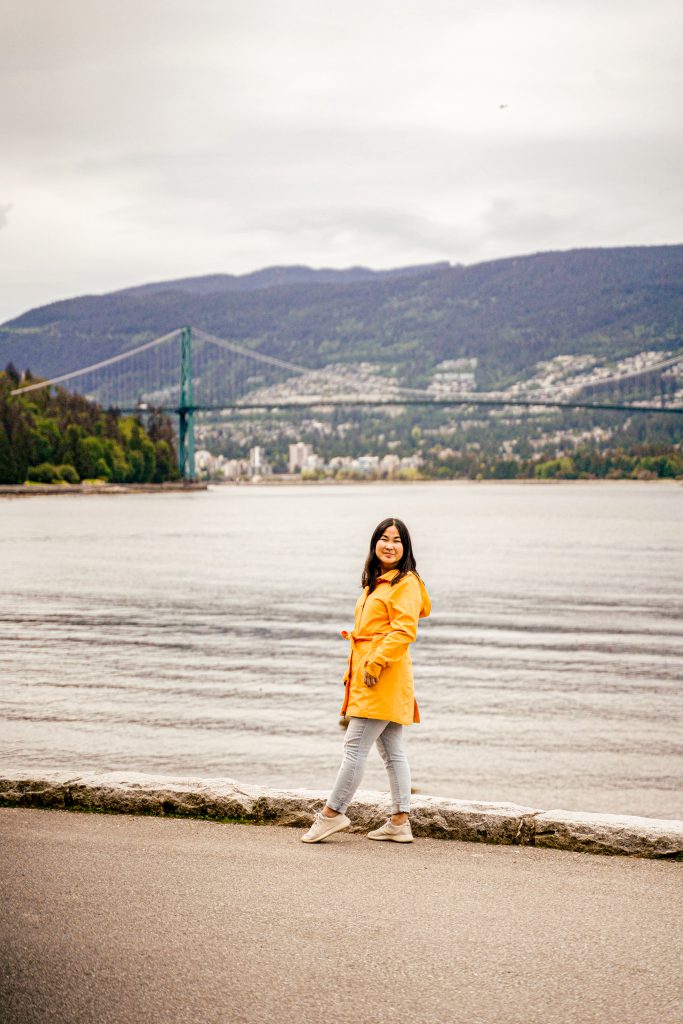
What to pack for Vancouver
- Comfortable/waterproof shoes: Allbirds and Rothy’s are usually my go-to travel shoes! I also brought these ankle boots (spray them to make them water-resistant!). Waterproof rain boots are also a good idea and I also wish I’d gotten my hands on some waterproof sneakers!
- Jacket: A light jacket like a denim jacket is perfect for warmer summer days. During cooler months, a packable down jacket will help you stay warm – this Patagonia one is my favorite.
- Rain jacket: A waterproof shell like this one is super compact and helpful to have for light rain. However, I also used my trip as an excuse to buy this rain trench coat and it kept me dry even in pouring rain (and it’s cute too)!
- Umbrella: Keeping a collapsible travel umbrella on hand is also super helpful!
- Power bank: To help keep your devices charged as you explore Vancouver!
- Reusable water bottle: Stay hydrated and reduce plastic waste by filling up a reusable water bottle throughout the day.
More Vancouver travel tips
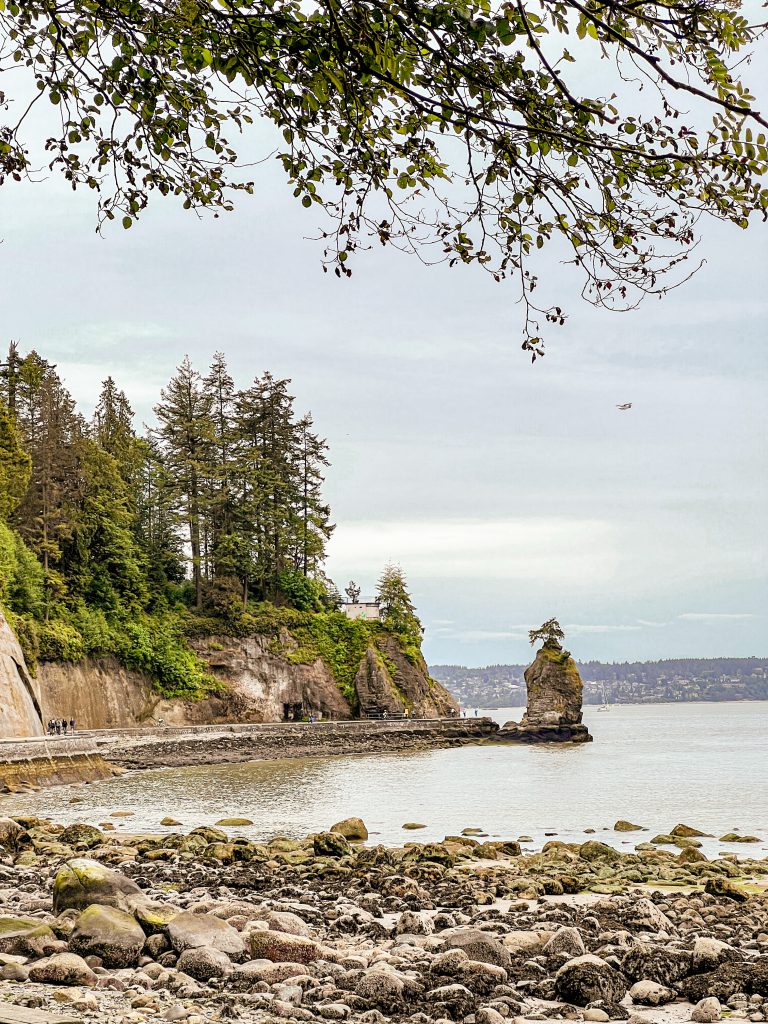
Currency + Money
Canada’s national currency is the Canadian dollar. If coming from the United States, the exchange rate works out to around $1.25 USD to $1 CAD (so it ends up being like an automatic 25% discount, woo!).
Virtually everywhere in Vancouver accepts credit cards, although there may be a handful of places that are cash only (i.e. inside Granville Market). I usually take out money at an ATM in the airport, but there are also plenty of banks all around the city where you can pull out cash if you need it.
Some establishments may also accept US Dollars, but the exchange rate is usually not favorable if you pay this way. Also note that when paying by credit card, you will not get the best rate if you use the pay with USD on the terminal.
Like the US, tipping is mandatory in Canada. For meals, expect to tip 15-20%.
Passport
May seem self-explanatory, but you DO need a passport in order to enter Canada – even if you are driving across the border!

Departing Canada
Note that if traveling back to the US, pre-departure clearance is common in Canadian airports, including at YVR. This means that you will complete immigrations and customs screening before leaving Canada (instead of upon arrival in the United States). Since lines can get long sometimes, allow extra time at the airport! However, if you have Global Entry, there is an expedited line available.

Where to stay in Vancouver
To make the most of your weekend in Vancouver, I highly recommend basing yourself downtown. This will make it super easy to get around and allow you to make the most of your stay and so you can see Vancouver in 2 days!
Within downtown Vancouver, here are some of the top neighborhoods to stay in:
- Gastown: This is where you’ll be the most central! Close to the top sights, transportation, and plenty of places to eat + drink.
- Yaletown: Located on the south side of downtown, Yaletown once used to be an old industrial area but has now been transformed into a trendy neighborhood with plenty of buzzy restaurants, cafes, and bars.
- West End: Bordering Stanley Park, you’ll find the best deals on accommodations here, as well as plenty of greenery and a diverse community in the West End. There are tonssss of delicious ethnic restaurants here!
And here are some recommended hotels:
L’Hermitage Hotel: I stayed here the first time I went to Vancouver, and I cannot recommend it enough! It is an absolutely beautiful property with impeccable service. I ordered a glass of wine from room service and it came on a silver platter, with a small dish of peanuts, a glass of ice water, and an orcid – that’s the kind of place this is!
The rooms are huge, with comfy beds, a giant tub, and even an electric fireplace. You also cannot beat the location – you’re in the middle of it all and it was so convenient to get EVERYWHERE!
It’s on the pricey side, but you can find deals, especially outside the peak tourist season (I paid ~$150 USD/night in April. Right now as I research for this article, I’m seeing ~$160 USD/night in October)
Grand Park Hotel: I stayed here my second time in Vancouver, and it is an awesome option if you’re looking for a conveniently located hotel at an affordable price point. It’s an apartment style hotel, which means that the rooms run a bit cheaper than staying in a traditional hotel. We were able to find rooms under $200 USD/night on a weekend in June, which is super affordable! You can get rooms for under $100/night outside of peak season.
The rooms are slightly dated, but super clean and comfortable, and the property seemed super safe. It also has a little kitchenette area with a sink, microwave, fridge, and some plates and utensils.
You also cannot beat the location at this price point – just a mile from Canada Place and Gastown.
The Burrard: I’ve always wanted to stay at the Burrard because of it’s super fun, colorful, retro vibe! The boutique hotel has a super convenient location just three blocks from the Robson Street shopping area.
There’s a beautiful outdoor courtyard area with fire pits and various lawn games, along with an on-site cafe. They also offer complimentary bike rentals, which is perfect for exploring the city!
The Perfect 2 Days in Vancouver Itinerary
Vancouver Itinerary Day 1 (Capilano Suspension Bridge + Downtown Vancouver)
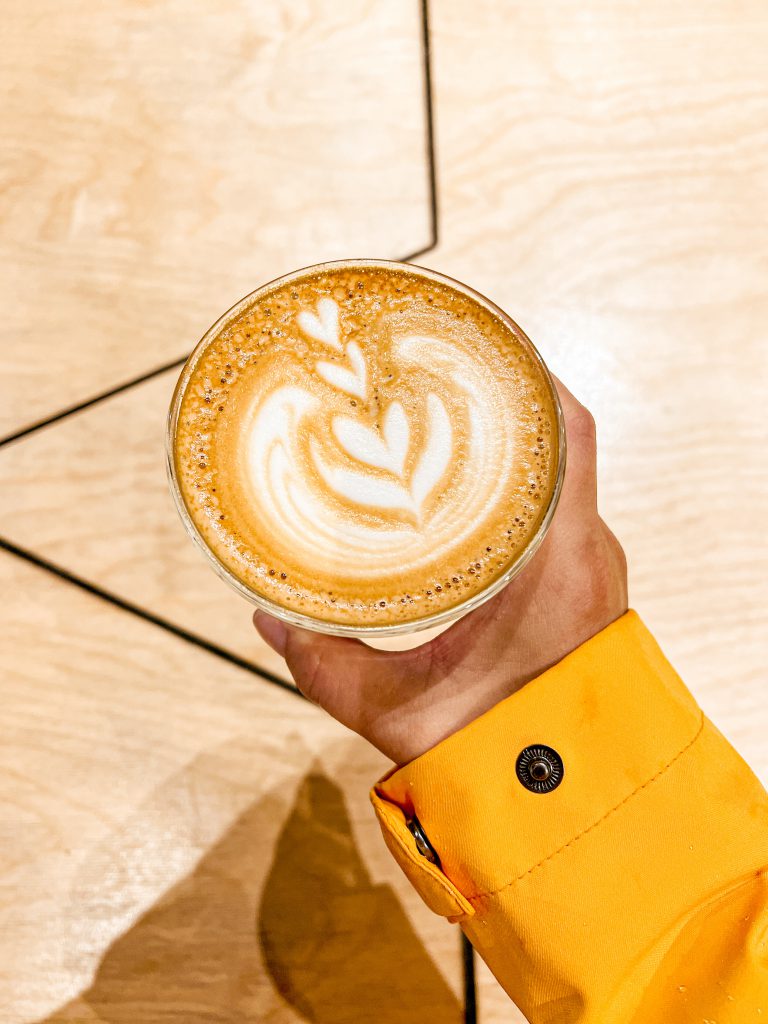
Coffee at Revolver
Start the first day of your 2 day Vancouver itinerary with a stop at Revolver Coffee. You’re going to have a big day, so a bit of a caffeine boost won’t hurt!
The hipster vibes here are immaculate, with rich wood details and metal accents. But also – the coffee is GOOD!
Located in the heart of Gastown, Revolver is one of the first third-wave coffee shops in Vancouver, and is also known to be one of the best in the city, and coffee snobs will appreciate that they can choose to have their drink made from a rotation selection of beans (hence the name “revolver”), but you don’t have to be a coffee snob to appreciate the quality.
Now that you’re caffeinated, onto the next stop on your Vancouver trip itinerary!

Capilano Suspension Bridge Park
Next, we will be heading to one of the most famous attractions in the Vancouver area – the Capilano Suspension Bridge Park! While it is technically located in North Vancouver, about 20 minutes from downtown, it is easily accessible from the city.
While you can certainly drive yourself there or take public transportation, I suggest taking the free shuttle bus that departs from Canada Place. The bus also picks up passengers at the Hyatt Regency and Blue Horizon hotels as well. Buses run every 30 minutes – see schedule here.
At $65.95 CAD (~$50 USD), it is a bit pricey. But, YES, I think it’s worth it, especially if it’s your first time in Vancouver! It’s a magical atmosphere, especially on a foggy day, and it’s one of the area’s most unique sights. I also think the biggest plus is that they offer the free shuttle – it makes it so easy to get to and saves time!
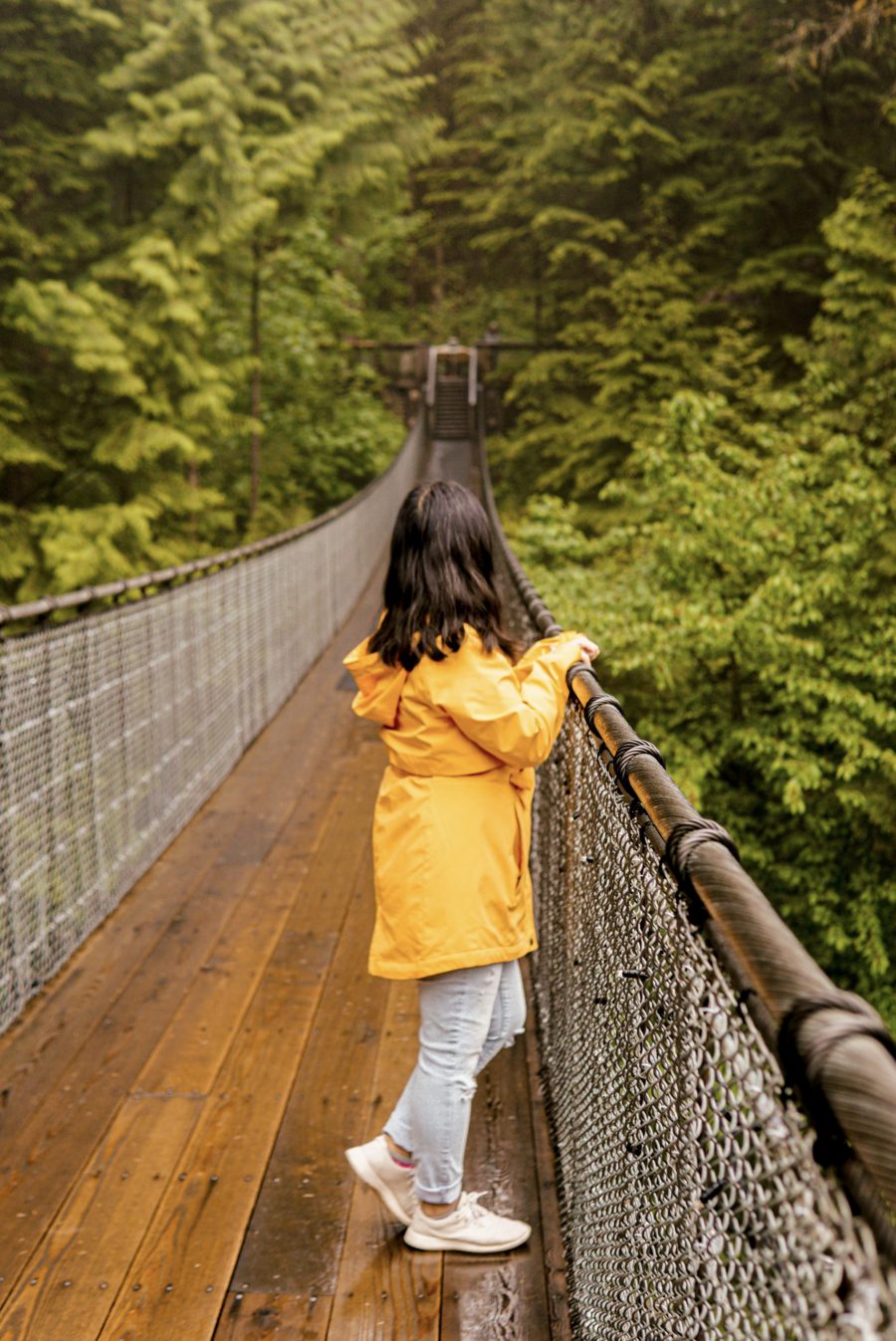

PRO TIP #1: I *highly* recommend hopping on the first bus at 8:30am to ensure that you will be one of the first people inside the park when it opens at 9am. This is one of Vancouver’s top attractions and draws over 1 million visitors a year – it is super popular and it can get BUSY! Book your ticket online ahead of time to avoid waiting in the ticket queue.
By arriving early, you’ll beat the crowds and we were even able to have the bridge to ourselves for a few minutes. By the time we left, it was swarming with people (the bridge sways more when there’s tons of people on it too!).
The highlight here is obviously the bridge, which stands 70 meters above the Capilano River, and stretches 135 meters across. Walking across the bridge is such a unique experience, feeling the gentle sway, feeling like you’re walking amongst the trees.
The views from the bridge are absolutely stunning – especially if you come on an overcast day, which gives it a really mystical feel which makes it look magical. This is one of those places that ends up being even BETTER in the rain! Which is good, because it’s been raining both times I’ve been here!
PRO TIP #2: While the bridge is the main attraction here, it is not the only thing that the park has to offer! Many people think that the bridge is the only attraction and don’t explore the other things to do here, which is a shame. Be sure to check out the park’s other sights while you are here!
One plus – the crowds thin out as you get away from the bridge!

On the other side of the suspension bridge is one of my favorite attractions in the park is the Treetops Adventures, a series of seven suspension bridges that hang directly in the canopy. It is super peaceful here, and the birds-eye views of the rainforest are absolutely breathtaking! I’d also love to see it in the winter when the Canyon Lights take place and illuminate the bridges and trees with twinkling lights.
There is also the Cliffwalk, a series of narrow bridges and walkways that jut out from the granite cliff high above the Capilano River. You’ll get a unique perspective of the river and rainforest, and enjoy some stunning views!


Finally, do not miss the collection of totem poles and exhibits dedicated to the First Nations tribes who once occupied the area. The name Capilano is derived from “Kia’pilano,” the name of a Squamish chief and also meaning “beautiful river.” You’ll find the largest privately owned collection of totem poles here, and the exhibits help you learn more about the indigenous people who once occupied the area.
All in all, expect to spend about 2-3 hours in the park. After you are done exploring the park and all of its attractions, hop on a shuttle headed back downtown to continue your Vancouver 2 day itinerary.
An alternative to Capilano Suspension Bridge – Lynn Canyon
If you’re on a budget and don’t want to pay for the Capilano Suspension Bridge, there is a second suspension bridge in Vancouver! This suspension bridge is located in Lynn Canyon Park, about 15 kilometers northeast of downtown, about a 25 minute drive.
Best of all, the Lynn Canyon park and suspension bridge are FREE! However, you do have to either have a car or arrange your own transportation. It is possible to get there via public transportation, although the trip takes almost an hour – from Waterfront Station, take the SeaBus to Lonsdale Quay and transfer to the 228 to Lynn Valley Center, then walk 15 minutes to the entrance.
Aside from the suspension bridge, Lynn Canyon Park also has numerous hiking trails and waterfalls, and is a beautiful place to enjoy nature right outside the city. Many people say that it gives you a much more authentic local experience than Capilano, which is built to be a tourist attraction.

Vancouver Waterfront
After coming back from the Capilano Suspension Bridge, spend a bit of time exploring the Vancouver waterfront. This area is technically known as Coal Harbour and extends all the way to the edge of Stanley Park.
While it can be a bit touristy, the waterfront has several cool sights and attractions that are worth checking out – and the views are breathtaking! Here, you can see the combination of the water along with the majestic mountains in the background, which makes you truly appreciate Vancouver’s natural beauty.
It’s also a fun place to watch the seaplanes taking off and landing here – or if you’re feeling adventurous, you can go on one yourself (I definitely want to do this sometime)!


The waterfront is also home to a number of public art pieces, including the Digital Orca, which looks like a pixelated whale and is meant to symbolize Vancouver’s natural beauty as well as life in digitized times.
It is also home to the Olympic Cauldron from the 2010 Winter Games, which took place in Vancouver. It looks especially cool when lit up at night!

Canada Place
Also located in the Vancouver waterfront is Canada Place, one of the most recognizable landmarks in the city. Characterized by the sails on top of the building, it is home to the Vancouver Convention Center, the Pan Pacific Vancouver Hotel, the World Trade Center, and cruise terminal, as well as numerous restaurants, bars, cafes, and other attractions. It is also the meeting point for many sightseeing tours.
One of the top attractions in Canada Place is the FlyOver Canada experience, a virtual flight experience that takes you on a simulated flight over the skies of Canada, soaring above its majestic landscapes with incredible special effects that make you feel like you’re actually flying! If you’ve ever been on Soarin’ at Disneyland’s California Adventure, then this is a similar experience.
Canada Place is also an ideal place to stop for lunch. Which brings us to…
Stop for lunch
For lunch, I am giving you two options, which are both some of my favorite restaurants in Vancouver:

Miku: Miku is located inside Canada Place, and specializes in Aburi Oshi, a type of sushi that is pressed into rectangular pieces and topped with seared fish. It is absolutely DIVINE – the fish melts in your mouth and is like butter!
It is on the fancier side, but their lunch menu is pretty affordable (especially if you’re coming from the US and factor in the exchange rate), and they have a selection of lunch combinations (which is why I suggested it for lunch).
I ordered the Lunch Shokai, which came with 10 pieces of sushi that were a mix of Aburi Oshi, rolls, and nigri, along with two appetizers. It was so beautifully presented and everything was absolutely delicious! My friend ordered the Aburi Chicken, a seared chicken marinated in a garlic soy sauce, and it was so flavorful and the chicken was so tender. Highly recommend!


Cafe Medina: Cafe Medina is *THE* brunch spot in Vancouver and I loved it so much the first time in the city that I came back on my next trip. They offer a selection of brunch dishes with a Mediterranean twist, and everything I’ve had here has been delicious!
They are known for their fricasées here, and I ordered a mushroom one and it was divine. We also got the tagine and it was so flavorful with the perfect amount of kick (despite being warned about the spice level). And whatever you do, you HAVE to order a Belgian Liege waffle – that’s what they are famous for!
It is a super popular brunch spot, so reservations are a must!

Dr. Sun Yat-Sen Classical Chinese Garden
After lunch, head over to Vancouver’s Chinatown, which is the third largest in North America (only behind San Francisco and New York City). Chinese immigrants have had a pivotal role in shaping the history and culture of Vancouver, and the city has a large Chinese population.
Chinatown is full of buildings accented with Chinese-style architectural details and street signs with Chinese characters, home to many dim sum restaurants, boba joints, bakeries, traditional herb shops, grocery stores, and much more. Be sure to check out the Millennium Gate, which represents the entrance to Chinatown and is modeled after gates found in southern Chinese villages.
One of the top attractions in Chinatown is the Dr. Sun Yat-Sen Classical Chinese Garden, which is a must visit during your 2 day Vancouver itinerary. Built in 1986, it is the first full-scale Chinese classical garden outside of Asia.
The authentic Ming Dynasty-style garden has numerous ponds, pavilions, walkways, bridges rock gardens, and traditional plants. The architectural details reflect Chinese history and traditional symbolism.


It is such a beautiful garden, and I enjoyed learning more about Chinese culture here. It is also a peaceful oasis in the middle of the bustling city (although I think there were a lot more people than I was expecting here).
The garden is also a venue for a variety of cultural programming, and hosts festivals, events, lectures, concerts, and classes that serve to create cultural and community connection.
There is also a free public park across from the gardens, which gives you a nice view of its pond and pavilions against the Vancouver skyline. Do note that you will have to exit the garden to get to the park.

Gastown
Gastown is Vancouver’s oldest neighborhood, and strolling through here makes it feel like you’ve taken a step back in time. You’ll find old brick buildings, cobblestone streets, and antique lamp posts here.
Here, you will find the famous Gastown Steam Clock, one of the most iconic sights in the city. It was built in 1977 to cover a steam grate over the city’s underground heating system, built to serve both as a landmark and to prevent homeless people from sleeping over the grate.

The antique clock is one of the only remaining steam powered clocks in the world, although it also uses gravity to power it as well. Many people wait in front of the clock to see it blow out steal and whistle, an occurrence that happens every 15 minutes.
You’ll find some interesting historical architecture in the neighborhood as well, including the Hotel Europe, known as Vancouver’s Flatiron Building, which is said to be haunted and has made an appearance in some movies.
Today, Gastown is one of the most vibrant areas in all of Vancouver, and you’ll find tons of bustling restaurants, trendy bars, hip cafes, shops, galleries, and much more. It’s a fun area to stop for dinner and/or take part in its nightlife!
More on that later, but we have one more stop before dinner…
*NOTE* The area in between Chinatown and Gastown, specifically on East Hastings Street, especially the blocks closest to Main Street, is known to have a large homeless population and drug use, among other issues. If you’ve spent any time in large cities (i.e. San Francisco, Los Angeles, New York, even Seattle), then this is nothing new. This is not necessarily to say that you are in any danger – Vancouver is considered to be a very safe city – it’s more of a heads up as if you are not used to seeing this, then it can be a bit jarring at first. As always, exercise caution at all times as you would in any other city.
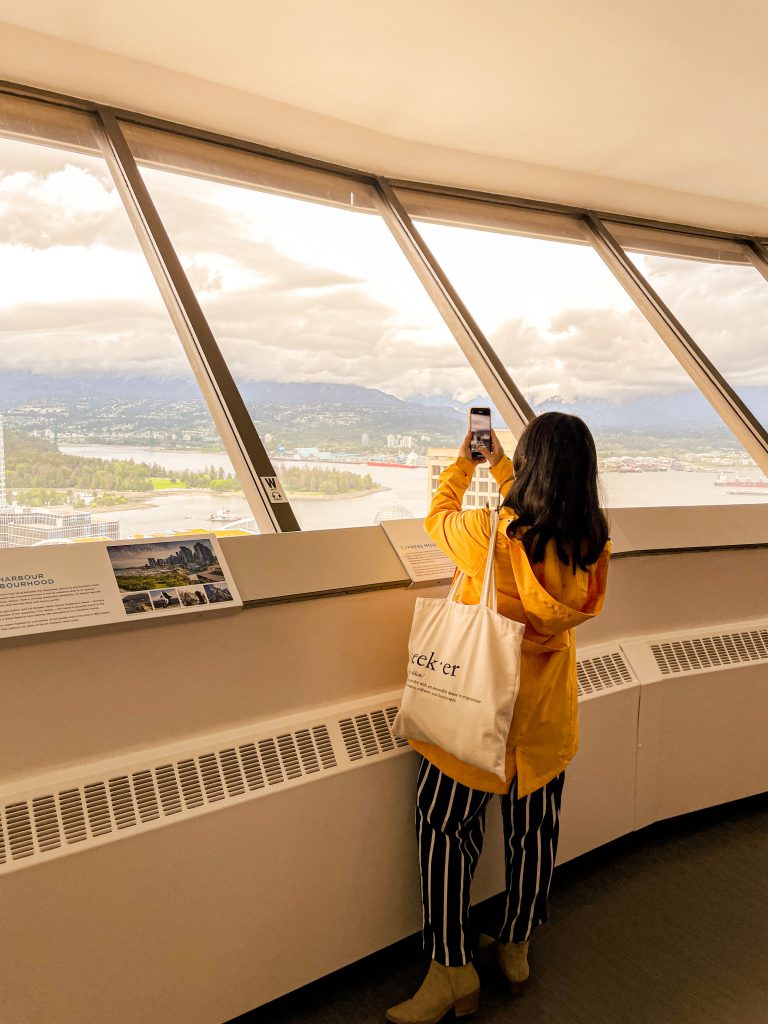
Vancouver Lookout
I’m always a sucker for a good view and a good observation deck, so obviously, I had to make a stop at the Vancouver Lookout. It’s kinda like the Space Needle of Vancouver (and even kinda looks like it too). Located at the Harbour Center, the Vancouver Lookout stands 168 meters (553 feet) tall and once used to be the tallest building in the city.
You can literally see the entire city from here – from a birds eye view of the downtown skyscrapers, Stanley Park, the waterfront, the surrounding mountain ranges, and beyond. There are legends that tell you exactly what you’re looking at, and I was really impressed at exactly how much you can see! There’s an audio guide to go along with it as well.


The best part is that it wasn’t crowded at all – even on a Sunday afternoon – so you can really take in the view without fighting hordes of other tourists (like you normally have to do in places like this).
I imagine that it would be even better at sunset, but even on an overcast day, the views were still pretty awesome!
Time for Dinner!
Ok, you’ve had a long but exciting first day on your Vancouver trip itinerary – so now you deserve a delicious dinner!
I’m going to give you a few options around downtown Vancouver, so you can pick based on what you’re in the mood for:

Japadog: This one is *super* casual, but it is a Vancouver institution and is a must sometime during your two days in Vancouver! Japadog serves up hot dogs with a Japanese twist – I’m talking okonomiyaki-style, with croquettes or yakisoba, or made with wagyu beef. They have vegan options as well!
While you *can* get just a regular hot dog here, I *highly* recommend that you get one of the Japanese-style ones! They are so unique and SO good – I LOVED the croquette one so much!
It used to be a stand on Robson Street, but is now an actual storefront, so you can stop in and eat or get it to go – up to you.
Chambar: Chambar is the sister restaurant of Cafe Medina, which I mentioned earlier as an option for lunch restaurants. I’ve actually only had dessert here (which was DIVINE), but Chambar is consistently ranked as one of the top restaurants in Vancouver and I really want to dine for dinner one of these days!
Chambar does French/Belgian cuisine with a Pacific Northwestern twist – think moules frites in a coconut tomato broth, or a curried mushroom puff pastry.
Phnom Penh: Located in Chinatown, Phnom Penh was high on our list but we sadly ran out of time and never made it here. You’ll find an extensive menu of Cambodian-Vietnamese cuisine, but the chicken wings here are supposed to be legendary!
It’s a super popular place and there’s usually a line, so plan accordingly!
After dinner…
If you still have some energy left after dinner and are looking for some fun things to do, here are a few suggestions:
- If you feel like taking a little walk around the area, head over to Creekside Park. This is the best place to see and take photos of Science World, which lights up at night and looks super cool! *note* there’s actually 2 Creekside Parks in the city – head to the one on Quebec Street, not the one near Granville Island
- Lost Souls of Gastown Tour: This renowned walking tour shows the rough and boisterous side of Gastown’s history and is totally wacky and unique! You’ll get to explore the neighborhood at night, and hear all the tales of murder, disease, revenge, and fires that once took place here, told via a theatrical performance by an in-character guide.
- Granville Street: This is the nightlife street in Vancouver, so if you’re looking to go bar hopping and/or hitting up some clubs, this is the place to go!
Vancouver Itinerary Day 2 (Yaletown, Granville Island, Stanley Park)

Yaletown
Get ready for another busy day of exploring! Start off the second day of your weekend in Vancouver in the Yaletown neighborhood.
Yaletown was once the western terminus for the Canadian Pacific Railway, and industrial neighborhood filled with warehouses and railroad yards. The area experienced a reinvention when Vancouver hosted the Worlds Fair in 1986, and the warehouses were eventually transformed into trendy restaurants, cafes, and lofts.
If you’re looking for somewhere to get your morning caffeine fix, stop by Black Echo, known for their butter espresso, Rocanini Coffee Roasters, known for their Instagrammable coffee drinks, or Matchstick, known to have some of the best coffee in the city along with some fantastic pastries.
Hungry? Yaletown is home to OEB Breakfast Co., one of the best breakfast spots in the city. They are known for their classic breakfast dishes with a twist, with unique benedicts, crepes, scrambles and even breakfast poutines. Do note that the wait here can be long – put your name on the online waitlist before you head out to save time!
Some other highlights in Yaletown include Bill Curtis Square, which is a super cute photo spot with the colorful umbrellas hanging overhead; and the Engine 374 Museum, which houses a historic steam engine that was the first trans-continental train to arrive in Vancouver back in 1887, and has exhibits about the neighborhood’s past as a railroad hub.

David Lam Park
Yaletown also boasts a number of beautiful green spaces that are located along the waterfront of False Creek. One of the best is David Lam Park, which has plenty of open grass, recreational opportunities, public art pieces, and impressive views of the downtown skyline.
It was pretty gloomy when we were there, but I imagine it is absolutely gorgeous on a sunny day!

Hop on a ferry to Granville Island
David Lam Park is also a stop for both the False Creek Ferries and AquaBus, which provide ferry service to Granville Island.
Sure, you can certainly walk there or use other modes of transportation, but what’s the fun in that? The historic ferries are super cute AND you get some amazing views out on the water, making this the best way to get there!
While these are two separate companies, they basically make the same stops, so you can hop on either one. Ferries run pretty frequently – every 15 minutes or less.
Fares are calculated on distance, and Granville Island is the next stop from David Lam Park, and fares are similar for both if you buy a round-trip ticket ($2.25 one way/$4 round trip vs. $3.25 one-way/$4 round trip). In either case, you can pay on board and credit/debit cards are preferred.
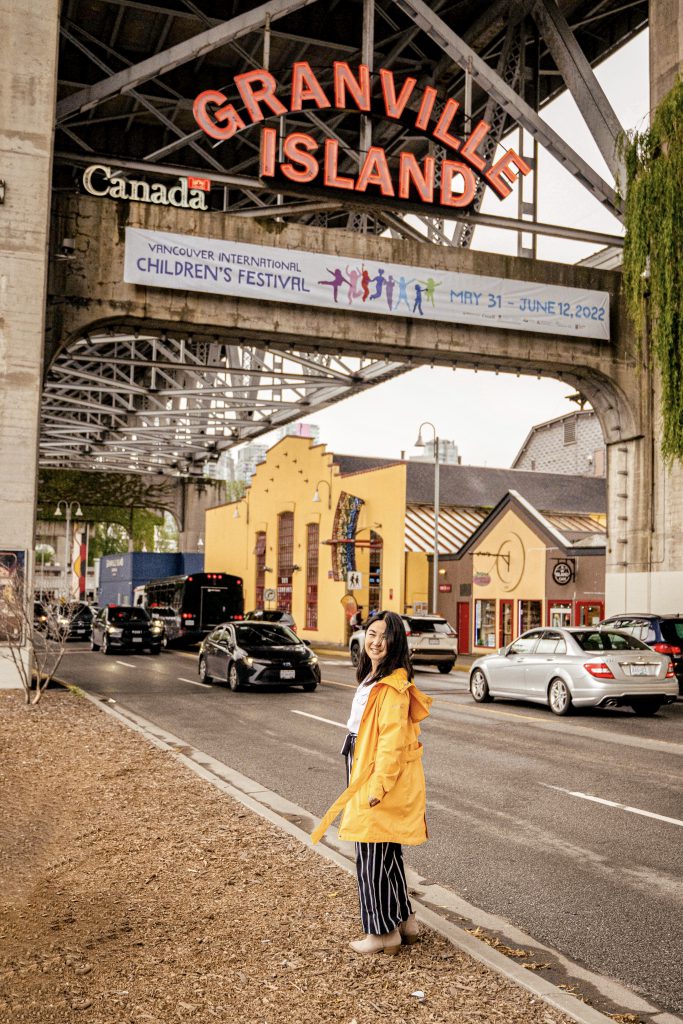
Granville Island
Once you hop off the ferry, you’ll land on Granville Island, a peninsula and shopping district that is also a foodie paradise. You can easily spend all day wandering around the island, browsing through the unique shops and sampling all of the different restaurants, breweries, and more.
The crown jewel of the island is the Granville Island Public Market, an indoor market that is similar to Pike Place in Seattle, with tons of stalls selling everything from fresh produce, seafood, gourmet cheeses, baked goods, local handicrafts, ethnic foods, and much more. This is a fantastic way to spend 2-3 hours! It’s a must even with a short time in the city (it’s even one of the best activities on a Vancouver layover).

I recommend taking a food tour of the market with a local chef, which is a great way to sample all the best of the market, and to discover some gems.
Granville Island is a great place to have lunch – you’ll have no problem finding tons of delicious things and there’s plenty of tables and eating areas both inside and outside of the market.



Here are some favorite places to check out:
- Lee’s Donuts: There will be a line out the door when you approach the market, and you’ll probably wonder what it’s for. You’ll find some of the best donuts in town here – definitely try the Honey Dip, as that is what they’re known for.
- A La Mode: They specialize in pies and pot pies, from traditional ones like chicken pot pie and apple pie, to some PNW-inspired ones like salmon chowder – which is what we had, and it was delicious!
- Sen Pad Thai: I was a bit skeptical about this place but I was really craving pad thai and it did not disappoint! The noodles are the perfect texture, really flavorful, and have the perfect amount of kick.
- The Stock Market: They specialize in bone broth soups, which really hit the spot on a rainy day.
- Granville Island Brewing Company: One of Canada’s original microbreweries. Order a flight and taste some local beers!

Stanley Park
Hope you had plenty to eat at Granville Island, because now we’re going to be working all that food off!
Your afternoon will be spent exploring Stanley Park, one of the highlights of your 2 days in Vancouver itinerary! Stanley Park is a 1000 acre green oasis right next to downtown Vancouver, and draws over 8 million visitors each year.
It is known as one of the best urban parks in the world and is like the Central Park of Vancouver – except that it’s actually larger than the famous New York City park.
The sprawling park is surrounded by water on all sides, and boasts beautiful rainforests, beaches, gardens, wildlife, historical landmarks, restaurants, cafes, and more. It is also home of the Vancouver Aquarium, which is home to over 70,000 marine animals and has an array of exhibits that educate visitors on marine ecosystems from the tropics to the arctic.
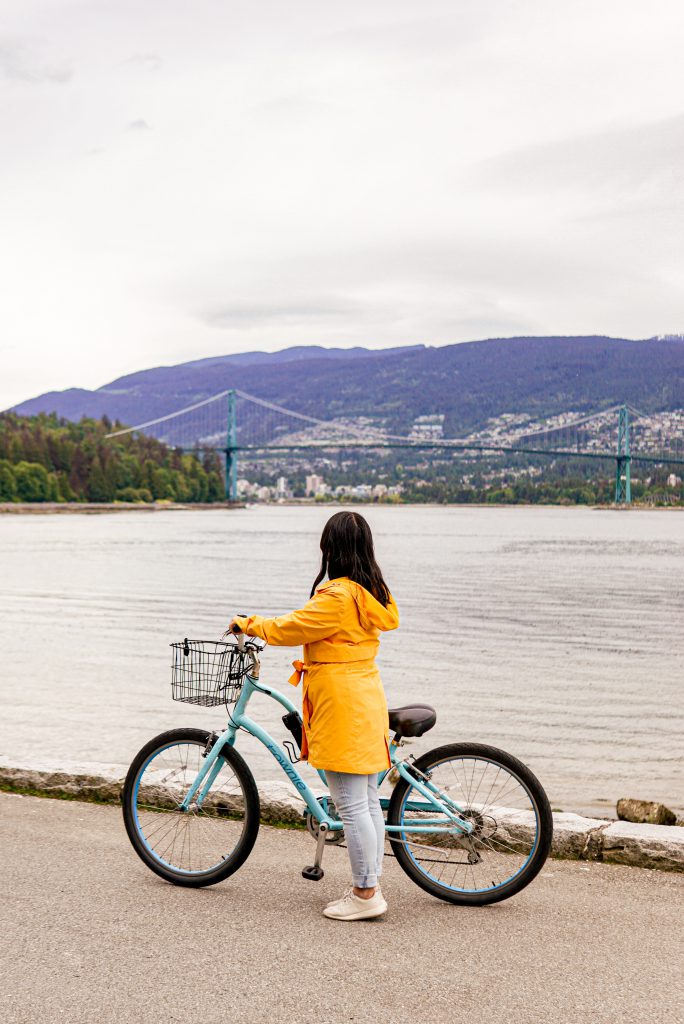
The best way to see Stanley Park – BIKE!
The highlight of Stanley Park is the 10 kilometer seawall, which goes around the perimeter of the park and passes through some of its iconic sights. While you can walk or run around the Seawall, I highly recommend hopping on a bike – it’s the best (and more efficient) way to see the park!
There are tons of bike rental shops in the West End on the streets bordering the park, offering both hourly and all-day rentals. We rented from Spokes, which offers rentals for a variety of bikes, including cruisers, e-bikes, tandem bikes, and more.
We got a regular cruiser and it cost $12/hour (it took us just under 3 hours to return the bike). Helmets and baskets are included as well. The process was super easy and we were on our way!
TIP: If it looks like there’s *any* chance of rain, grab a poncho at the bike rental shop (or make sure you’re wearing a waterproof jacket). My first time in Vancouver, I went to bike the Seawall, and when I picked up the bike, it was very overcast, but no rain yet. By the time I got into the park, it started drizzling.
By the time I was halfway around the Seawall when it started POURING! I only had an umbrella with me so I stood there trying to wait it out, except it never did. Meanwhile, everyone else I saw on bikes had ponchos that the bike rental place gave them and I was kicking myself for not grabbing one. After an hour or so, I decided to just bike back despite the pouring rain because it didn’t look like it was going to let up – of course it stopped raining as soon as I dropped off the bike.
But anyways…the Seawall is relatively flat throughout, with clearly marked bike lanes. Even though I’m not a great cyclist, I managed it just fine (minus the rain that first time…lol).
You can bike through the Seawall in an hour, but we made tons of stops along the way to ooooh and aaah over everything (it really is beautiful!), so it took us close to three hours. There are tons of interesting landmarks and incredible views along the way!
Here are some of the stops I suggest making when biking along the Stanley Park Seawall:


- Vancouver Seawall Viewpoint: I’m not actually sure what this area is called, but it is soon after you enter the park, where all the boats are. I love this viewpoint because it is the juxtaposition of city and nature – seeing all the greenery and the coastline, along with the urban skyscrapers of downtown in the background.
- Brockton Point Lighthouse: This historic lighthouse is super striking because of its red and white exterior. Built in 1914, it was intended to help ships navigate the treacherous waters of Coal Harbour and warn them of impending storms.
- Totem Poles: You’ll have to make a slight detour off the Seawall to see the totem poles, but it is well worth it. The collection of nine totems were originally brought to the park with the intention of building a First Nations village inside the park, and highlight tribes that are local to the Vancouver area, as well as around British Columbia.
- Girl in a Wetsuit: This statue of a woman in a wetsuit, with flippers on her feet and a mask on her head sits on a rock just offshore of the park. It is inspired by the Little Mermaid sculpture in Copenhagen.
- Lions Gate Bridge: The iconic bridge is sort of like the Golden Gate Bridge of Vancouver. You’ll find some amazing views of the bridge while biking around the Seawall, as well as biking directly underneath it!


- Siwash Rock: This is sometimes called “Pineapple Rock” because it is said to look like a pineapple, but it doesn’t really look like one to me. The rock/island gets its shape because it split off from the main cliff over time due to erosion. It’s one of the most iconic sights in the park.
- Stanley Park Teahouse: Another slight detour from the Seawall, but it’s an awesome spot to stop for a break and enjoy a warm beverage.
- Beaches: Stanley Park boasts some beautiful beaches, both with pretty views and a PNW vibe. Second Beach also has a heated outdoor pool, while Third Beach offers a more secluded feel.

Prospect Point
Prospect Point is one of the most famous viewpoints in Vancouver, and one of the best places to photograph the Lions Gate Bridge. It’s also really unique because you get a vertical perspective of the bridge.
The Lions Gate Bridge connects downtown Vancouver with North Vancouver, and is one of the most iconic landmarks in the city, as well as a National Historic Site. The name refers to the Lions, a pair of mountain peaks located north of the city.
It’s located at the northernmost point of Stanley Park. While you can try to bike there, you will have to go uphill quite a bit so I’d suggest taking an Uber or driving there.
Unfortunately, it was starting to rain when we dropped off the bike so we didn’t make it over here, but it would be a fantastic place to go around sunset, when you can see the lights of the traffic glow against the dusk sky!
Dinner in West End
After exploring Stanley Park, head over the West End neighborhood to stop for some dinner. This area has a chill, eclectic vibe, and is best known for its diversity – it’s also Vancouver’s LGBTQ district.
You’ll find some amazing Asian food in the area, particularly Japanese food. If you’re thinking “this girl is suggesting a lot of Japanese food” – well, you’re probably right, but Vancouver has some AMAZING Japanese food, especially in the West End (and that is coming from a Japanese girl).
Here are some suggested spots for dinner:
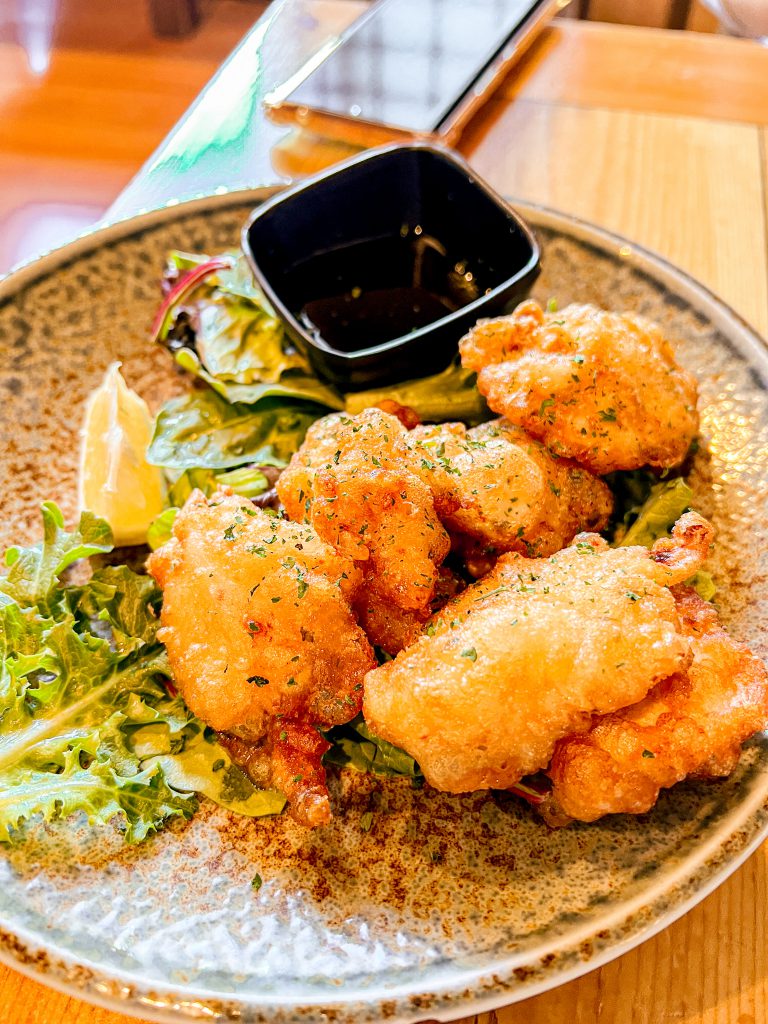

Guu for Garlic: One of Vancouver’s original izakayas, which is basically a Japanese pub/tapas restaurant. I’ve been here twice now and I’ve really enjoyed everything I’ve tried here!
They have an extensive menu of izakaya favorites, both traditional and with a twist, and it’s hard not to keep ordering because you want to try it all! I loved the yakiudon, okonomiyaki, chicken tempura with yuzu pepper ponzu, and niku jaga croquette, among other things!
They have beer, wine, and sake, along with sake/shochu cocktails. Try the sake mojito drinks, which come with a ramune bottle, where you press down the glass marble and pour it directly into the rest of the drink – so fun!

Marutama Ramen: Marutama is consistently ranked as one of the best ramen spots in the city (which has MANY ramen spots!), and it does not disappoint. They specialize in tori paitan style, or chicken broth, which is lighter than a tonkotsu broth but super creamy and flavorful!
It’s a super popular spot, expect a wait, or go early!
Ramen Danbo: I went here my first time in Vancouver, and the tonkotsu broth here is super rich and satisfying! It really hit the spot on a cold, gloomy day, especially after I got soaked when biking around the park.
Kingyo: I haven’t been to Kingyo yet, but I did go to Rajio, their sister restaurant in Kitsilano and it was delicious! Kingyo is known as one of the best izakayas in town. They boast a menu of creative Japanese small plates, like Kobe beef that you grill on a mini hot-stone grill. They also have izakaya classics like tuna tataki, ebi mayo, and more, as well as sushi.
It is super popular, so be sure to make a reservation!
Have you ever been to Vancouver? What would you include on your Vancouver 2 day itinerary?
You might also like:
30 Fun Vancouver Rainy Day Activities
2 Days in Seattle Itinerary
The Perfect One Day in Seattle
2 Days in Quebec City Itinerary
Quebec City in Winter Travel Guide
Montreal in Winter Travel Guide
2 Days in Portland, Oregon
Like this post? Save this 2 days in Vancouver itinerary on Pinterest for later!


Caroline is a Southern California based traveler, writer, and photographer. She travels all around California, the US, and the world in search of the most colorful places, the most delicious food, and bucket-list adventures. Her aim is to inspire other travelers discover how to add more adventure and joy to their lives. On Pictures & Words, you’ll find detailed guides + itineraries, along with vibrant photos to help you plan the the most epic trips. When she’s not traveling, Caroline also runs half marathons.
